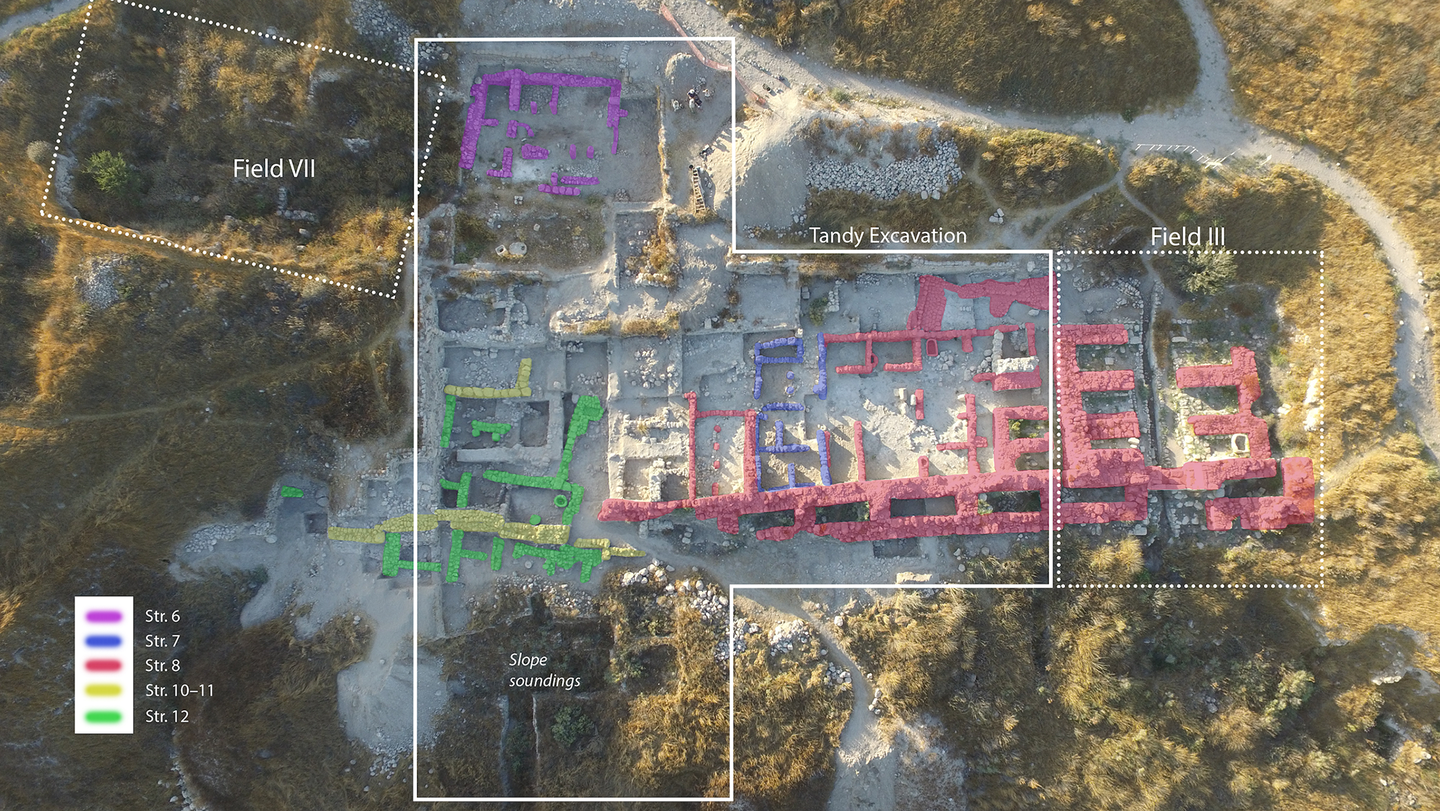Archeologists unlock secrets of biblical events from ancient city
Archaeologists have harnessed the power of radiocarbon dating to unveil the truth behind events chronicled in Biblical texts

[Nov. 19, 2023: JD Shavit, The Brighter Side of News]
Aerial view of the Tandy excavations, with a wide exposure of iron age strata on the central-southern edge of the Gezer mound between fields VII and III of Hebrew Union College. (CREDIT: PLOS)
Archaeologists have long sought to bridge the gap between the narratives of ancient texts and the tangible evidence hidden beneath the earth's surface. In a groundbreaking study published in the prestigious PLOS ONE scientific journal, archaeologists have harnessed the power of radiocarbon dating to unveil the truth behind events chronicled in Biblical texts, particularly those centered around the enigmatic ancient Levantine city of Gezer.
This captivating journey through time takes us back to the heart of Gezer, an archaeological site nestled in the historic landscapes of Israel. For centuries, Gezer has captivated the imagination of scholars and theologians alike, with its mention in Egyptian, Assyrian, and Biblical texts. In this narrative, we explore how radiocarbon dating has shed new light on this ancient city's tumultuous history, confirming some long-held beliefs while challenging others.
Radiocarbon Dating: A Window into the Past
To unravel the mysteries of Gezer's past, a team of dedicated archaeologists embarked on a journey that took them deep beneath the layers of time. Armed with radiocarbon dating technology, they meticulously analyzed 35 organic materials, primarily seeds, extracted from various layers of sediment at the Gezer site. This treasure trove of ancient organic matter spans a critical period from the 13th to the 9th centuries BCE, a time when Gezer witnessed cataclysmic changes, including destructive events and periods of rebuilding.
Map showing location of the city of Gezer with respect to other important cities and Jerusalem. (CREDIT: holylandphotos.org)
Lyndelle Webster, a study author hailing from the Austrian Academy of Sciences, emphasized the significance of their work, stating, "Our publication provides the first radiocarbon-based chronology for Tel Gezer in the period 13th through 9th centuries BCE. This allowed us to independently test whether the correlations that have been proposed between certain archaeological layers and events from written sources are feasible from a chronological point-of-view."
Matching the Pieces of the Puzzle
As the radiocarbon dates began to emerge, they wove a tapestry of Gezer's history, aligning with certain events vividly detailed in Biblical and other ancient texts. One such match was the destruction of Gezer under the reign of the pharaoh Merneptah, a momentous event that echoed across the ages.
The study's findings paint a vivid picture of this destructive episode. "Most walls of the administrative building had fallen in the same direction (westward), and the structure was buried in up to 1.5 meters of mudbrick debris; concentrations of boulders filled some rooms," the study noted. This devastation appeared to have caught the city's inhabitants off guard, as the building was discovered mostly empty.
Related Stories
Furthermore, the research team discovered compelling evidence supporting the Biblical account of the ancient Egyptian king Shishak's involvement in the fall of Gezer. This revelation, backed by radiocarbon dating, adds weight to the historical narrative, solidifying the existence of Shishak as the first Egyptian king mentioned by name in the Bible.
The destructive event associated with Shishak, much like that of Merneptah, aligned with the radiocarbon dates, suggesting that the ancient city of Gezer bore witness to a fiery and sudden demise.
Challenges to Historical Correlations
However, not all correlations between Gezer's archaeological record and ancient texts stood the test of time. The radiocarbon dating results cast doubt on the proposed link between Gezer's fall and the campaign of Hazael, an ancient ruler first mentioned in 1 Kings 19:15-17.
Remains of the ancient city of Gezer. (Credit: Steve Ortiz)
"These dates suggest, for example, that the correlation of a certain destructive episode with the actions of the pharaoh Merneptah is plausible, while the proposed link between another such episode and the campaign of Hazael is not," the study's press release pointed out. While Hazael's campaign may have been a significant historical event, it appears that it did not leave a discernible mark on Gezer's archaeological record during the specified period.
The Quest for Truth Continues
This groundbreaking study not only uncovers the hidden layers of Gezer's history but also provides a robust dataset that will enable researchers to explore the intricate interplay between archaeological evidence and ancient texts. By offering an independent source of absolute dates, this research allows scholars to better understand the events that unfolded in Gezer and place them within a broader regional context.
Location of the Tandy excavation relative to previous archaeological fieldwork at Gezer. (CREDIT: J. Seger)
As the findings reveal, Gezer bore witness to destructions associated with powerful figures like Merneptah and Shishak, reinforcing the historical narratives present in the Bible. These revelations breathe life into the annals of history, allowing us to connect more deeply with the past.
Nonetheless, the study's challenges to previously held correlations serve as a poignant reminder that the quest for historical truth is an ongoing journey. It prompts us to continue exploring the intricate tapestry of history, unearthing hidden stories and deciphering the mysteries of our ancient past. As we delve deeper into the annals of time, the radiocarbon dating technology continues to be an invaluable tool, shedding light on the shadows of history and revealing the truths that lie beneath.
For more science stories check out our New Discoveries section at The Brighter Side of News.
Note: Materials provided above by the The Brighter Side of News. Content may be edited for style and length.
Like these kind of feel good stories? Get the Brighter Side of News' newsletter.
Joshua Shavit
Science & Technology Writer | AI and Robotics Reporter
Joshua Shavit is a Los Angeles-based science and technology writer with a passion for exploring the breakthroughs shaping the future. As a contributor to The Brighter Side of News, he focuses on positive and transformative advancements in AI, technology, physics, engineering, robotics and space science. Joshua is currently working towards a Bachelor of Science in Business Administration at the University of California, Berkeley. He combines his academic background with a talent for storytelling, making complex scientific discoveries engaging and accessible. His work highlights the innovators behind the ideas, bringing readers closer to the people driving progress.



